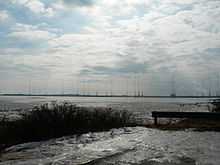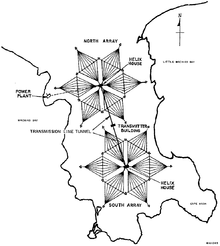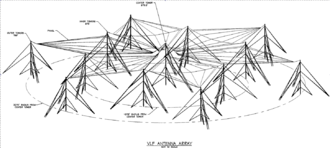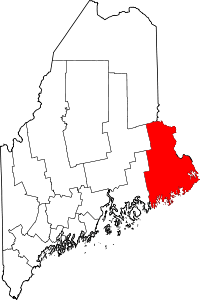VLF Transmitter Cutler


The VLF Transmitter Cutler is the United States Navy's very low frequency (VLF) shore radio station at Cutler, Maine. The station provides one-way communication to submarines in the Navy's Atlantic Fleet, both on the surface and submerged. It transmits with call sign NAA, at a frequency of 24 kHz and input power of up to 1.8 megawatts, and is one of the most powerful radio transmitters in the world. It was originally located in Arlington Virginia.
Started Arlington Virginia
The station began operations in 1913 as a radio telegraphy station call sign NAA in Arlington, Virginia, at a facility next to Fort Myer.[1] Although its broadcasts occasionally included band concerts and speeches, it was most famous for its nightly time signals. The three towers known then as "The Three Sisters" stood 600 feet, 450 feet and 200 feet (183, 137, and 61 m) above the ground. The site was referred to as "Radio", Virginia.[2] The towers were the second largest man-made structure in the world behind only the Eiffel Tower. The word "Radio" was first used instead of "Wireless," in the name of this Naval Communications facility. The First Trans-Atlantic voice communication was made between this station and the Eiffel Tower in 1915. The Nation set its clocks by the signal and listened for its broadcast weather reports. The Towers were dismantled in 1941 as a menace to aircraft approaching the new Washington National Airport.[1][2][3][4] The towers stand today at United States Naval Academy in Maryland, on the edge of the Chesapeake Bay.[1]
Moved to Cutler Maine
The current Cutler Naval Station was built in 1960 and became operational on January 4, 1961. It has a transmission power of 2 mega watts, and it was at one time, and perhaps still is, the most powerful radio transmitter in the world. As with all VLF stations, the transmitter has a very small bandwidth, and so cannot transmit audio (speech) but only coded text messages, at a relatively low data rate. The transmission consists of a continuously encrypted Minimum Shift Keying (MSK) signal capable of multi channel operations.[5] The transmitter operates on 24.0 kHz. In the past it operated on 17.8 kHz. The callsign of the station is NAA.
Antenna


The extensive antenna system consists of two separate identical arrays, designated the “north array” and the “south array”.

Each array consists of a ring of 13 tall metal masts connected at the top by a network of horizontal cables. The cables form six diamond-shaped "panels" radiating from the central tower in a hexagonal pattern shaped like a snowflake. The two arrays normally operate together as one antenna, but each is designed to function independently to allow maintenance on the other array. The central tower of each antenna system is 304 m (997.5 ft) tall. It is surrounded by six 266.7 m (875 ft) tall masts, placed on a ring with a radius of 556 m around the central tower. The remaining six towers of the array are 243.5 m (799 ft) tall and placed on a circle of 935.7 m (3070 ft) around the central tower.[6]
Each element (“panel”) of the antenna is suspended between the central tower, two towers of the inner ring and one tower of the outer ring. The entire array is 6140 ft (1.871 km or 1.16 miles) in diameter.
This type of antenna array is called a trideco or umbrella antenna. It functions as a capacitively top-loaded electrically short monopole antenna. The vertical steel masts of the antenna radiate the VLF radio waves, while the suspended cable array functions as a large capacitor, increasing the efficiency of the vertical radiators, At the base of each mast is a star-shaped network of cables suspended a few feet above the ground, extending out hundreds of feet, called a counterpoise, which serves as the bottom plate of the "capacitor".
The climate in Maine results in severe icing of the antenna wires during the winter, resulting in unacceptably large loads on the supporting structures. Therefore the antennas have a deicing system which runs large 60 Hz electric currents through the wires, heating them, to melt the ice. The power required for deicing is 3 MW, higher than the transmitter output power. An antenna array cannot transmit while it is being deiced, and one reason for having two arrays was to allow one array to be deiced while the other provides crucial uninterrupted transmission capability. Repairs and adjustments to an array can also be made without interrupting transmission.
Antenna maintenance
Antenna maintenance is performed during the summer months. During maintenance periods the station transmits on one array while work is performed on the other array, which is grounded. This allows continuous transmission, crucial since the Navy closed Annapolis (NSS), the only other East Coast VLF station.
The region where the two arrays come close together, near the transmitter house, is called the "bow-tie area". There are two panels and three towers from each array in this area. The fields on the grounded array are highest in the bow-tie area due to proximity to the active array. The present station operating procedure, based on a past RADHAZ survey, does not allow work on the bow-tie area towers or panels while transmitting on the other array. There is an ongoing tower painting project at Cutler scheduled for completion over the next few years. Under the present station policy, completion of this project would require several months of total downtime, which is unacceptable.
Test transmissions have been arranged, during which, only four panels of one array are connected to the transmitter. The objective of the four-panel tests was to allow painting and normal maintenance on the bow-tie area towers of the inactive array. A secondary objective of the tests is to characterize the antenna operating parameters which had not been measured since changing to 24.0 kHz.
In Popular Culture
In the 1950 film Destination Moon, when the astronauts land on the Moon they contact Washington by a radio call to NAA. In reality for power and antenna length reasons, as well as transmission through the atmosphere and path loss, a short, rather than long wave system would have been used. But as noted above there was no station with this callsign in operation when the movie was made.
See also
- Jim Creek Naval Radio Station
- Naval Communication Station Harold E. Holt
- Lualualei VLF transmitter
- List of masts
References
- ↑ 1.0 1.1 1.2 "Virginia Historical Marker". Virginia Historical Marker. Retrieved December 13, 2013.
- ↑ 2.0 2.1 "NAA". w4ava. Retrieved December 13, 2013.
- ↑ "Arlington Wireless Towers Coming Down". free lance-star. Jan 2, 1941.
- ↑ White, Thomas H. (January 1, 2006). "Washington, D.C. AM Station History". Retrieved 2006-10-11.
- ↑ Marten, M. (2007). Spezial-Frequenzliste 2007-2008, Band 2 (in German) (17th ed.). Meckenheim, Germany: Siebel Verlag. p. 36. ISBN 978-3-88180-665-7.
- ↑ Klawitter, G.; Herold, K. & Oexner, M. (2000). Langwellen- und Laengstwellenfunk (in German). Meckenheim, Germany: Siebel Verlag. pp. 82–83. ISBN 3-89632-043-2.
Further reading
- "NCTCS, Cutler Maine; NCTAMS LANT DET, Cutler East Machias, Maine". GlobalSecurity.org. Retrieved 2008-02-06.
- A Lockportian Goes "Down East" In Maine (includes photos of NAA towers)
- Hansen, P. (September 1994). "VLF Cutler Hollow Core Cable Repair/Replacement (Technical Report 1681)" (PDF). Retrieved 2008-02-07.
- http://eyeball-series.org/cutler-eyeball.htm
- http://www.lockport-ny.com/QCWA/activities.htm
Coordinates: 44°38′47.02″N 67°16′51.85″W / 44.6463944°N 67.2810694°W


